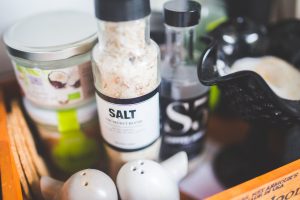 If you haven’t heard about Himalayan salt, it’s the pink salt that many believe is healthier than table salt. It comes from an area near the Himalayas that’s in Pakistan. The color is natural due to minerals it contains that were deposited millions of years ago. The additional minerals are also why people think it’s healthier than regular table salt. Unfortunately, there’s not much evidence backing that belief or opposing it. Are there enough minerals? Is it worth the effort and extra price?
If you haven’t heard about Himalayan salt, it’s the pink salt that many believe is healthier than table salt. It comes from an area near the Himalayas that’s in Pakistan. The color is natural due to minerals it contains that were deposited millions of years ago. The additional minerals are also why people think it’s healthier than regular table salt. Unfortunately, there’s not much evidence backing that belief or opposing it. Are there enough minerals? Is it worth the effort and extra price?
Salt is sodium chloride—HCL.
If you made a list of salt from the most processed to the most unprocessed, Kosher salt would be the most processed followed by iodized table salt, sea salt, Maldon Sea salt—a type of delicate finishing salt, Himalayan Sea salt, and finally the least processed, fleur de sel. All these types of salt are primarily sodium chloride—HCL. The highly processed types have impurities removed and additional ingredients, like anti-caking substances or iodine, added.
It’s the natural harvesting of pink Himalayan salt that allows the trace elements to remain.
There are estimates of up to 84 different trace elements and minerals in Himalayan salt. One of the most responsible for the pink color is the iron it contains. It’s harvested by hand and minimally processed to retain those impurities and commands a higher price because of them. Besides being used in food, large blocks are used for salt lamps and candle holders with the belief they impart health benefits, such as improving sleep quality.
You get more minerals and less sodium with Himalayan salt.
Himalayan salt is often coarsely ground so you need more to get the same salty flavor. If you use one teaspoon of Himalayan salt compared to one teaspoon of regular table salt, you’ll decrease the amount of sodium in your diet. It’s not ground as finely, so it isn’t packed as tightly as table salt. Since it’s not processed as much, it contains beneficial mineral impurities. They can help balance electrolytes and support better sleep.
- One thing Himalayan salt does not contain is iodine that many people require to avoid thyroid issues like goiters or birth defects if the deficiency occurs during pregnancy.
- Some people believe that the blend of the minerals in Himalayan salt is perfect and allows the body to absorb each nutrient more efficiently. They also believe that its trace minerals help promote cellular hydration.
- Himalayan salt lamps, salt caves, and inhalers are popular for people with respiratory problems, including allergies and asthma. They believe it cleans the respiratory pathways and eliminates many allergy symptoms.
- Himalayan salt is used for cooking, creating lamps and platforms to cook on, and as a beauty aid for exfoliation. It’s a good scrub, exfoliating the skin gently, leaving it smooth and soft.
For more information, contact us today at Rising Fitness Gym
